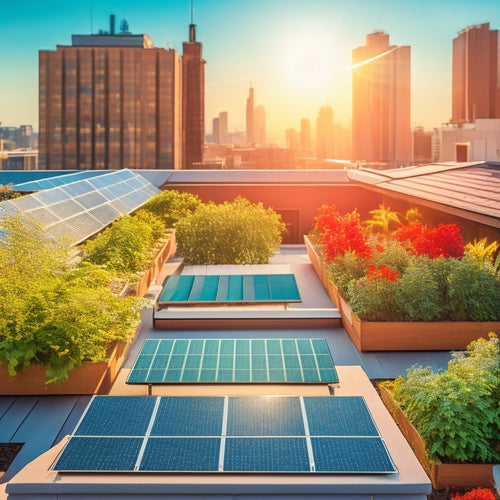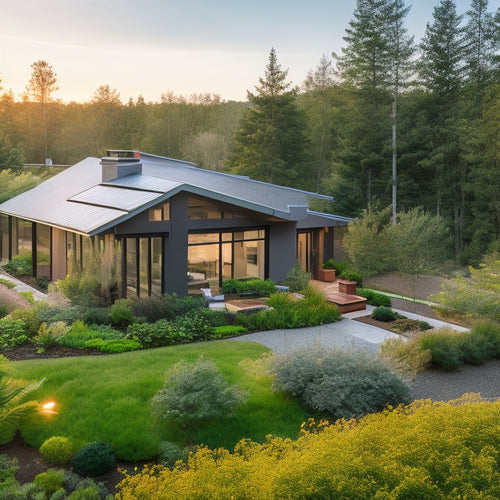
What Are the Key Costs of Solar Panels for a House
Share
You'll typically need to budget between $15,000 to $30,000 or more for a residential solar panel system, depending on the system size, equipment quality, and local labor costs. This initial investment covers solar panels, mounting hardware, inverters, and components, with financing options like loans and credit cards available to help. You'll also need to factor in additional expenses like installation labor costs, inverter replacement costs, battery storage costs, maintenance and repair costs, permitting and inspection fees, and monitoring and tracking costs. As you consider these costs, there's more to investigate to guarantee you're getting the most out of your solar panel investment.
Key Takeaways
- Initial investment costs for solar panels range from $15,000 to $30,000 or more, depending on system size and equipment quality.
- Labor costs vary depending on regional rates, installation complexity, and job duration, with average hourly rates ranging from $50 to $100.
- Inverter costs include initial installation (up to $3,000) and replacement costs every 10-15 years, with high-efficiency inverters minimizing energy losses.
- Battery storage costs range from $8,000 to $15,000+ for high-capacity systems, with lithium-ion batteries favored for energy density and lifespan.
- Ongoing maintenance and repair costs include quarterly panel cleaning, monthly performance monitoring, and inverter replacement every 10-15 years.
Initial Investment Costs
Your solar panel system's initial investment cost is the upfront expense of purchasing and installing the equipment. This cost includes the solar panels themselves, mounting hardware, inverters, and other necessary components.
The initial investment cost can vary depending on the size of your system, quality of equipment, and local labor costs. However, you can expect to pay anywhere from $15,000 to $30,000 or more for a typical residential solar panel system.
Fortunately, there are financing options available to help make solar energy more accessible. You can consider taking out a loan or using a credit card to cover the initial investment cost.
Additionally, you may be eligible for tax incentives, such as the Solar Investment Tax Credit (ITC), which can help offset the cost of your solar panel system. The ITC allows you to claim a tax credit of up to 26% of the total cost of your system.
Installation Labor Costs
When you're calculating the installation labor costs for your solar panel system, you'll need to take into account three key factors: the per hour labor rate of the installers, the complexity of the installation, and regional labor variance.
These factors can greatly influence the overall cost of the installation, and understanding how they interact is essential for making an informed decision.
Per Hour Labor Rate
The per hour labor rate is a significant component of installation labor costs, accounting for a substantial portion of the overall expense of solar panel installation.
As you consider investing in solar energy, it's crucial to understand the hourly wage of the installation team, which varies depending on the labor market and location. In areas with high demand and limited labor supply, you can expect higher hourly rates.
On average, the per hour labor rate for solar panel installation ranges from $50 to $100 per hour, depending on the complexity of the job and the installer's skill.
You'll need to factor in the total number of hours required for the installation, which can vary from 10 to 50 hours or more, depending on the size of your system.
When calculating the total labor cost, you'll need to multiply the per hour labor rate by the total number of hours worked.
Be sure to ask your installer about their labor rate and the estimated number of hours required for the installation to get an accurate estimate of your total labor costs.
Complexity of Installation
Solar panel installation labor costs also depend on the complexity of the job. You'll face varying installation challenges that affect the installation timeline and, ultimately, the costs. For instance, a simple installation on a single-story home with a straightforward roof layout will be faster and cheaper than a multi-story home with a complex roof design.
| Installation Complexity | Installation Timeline | Labor Cost Impact |
|---|---|---|
| Simple roof layout | 1-3 days | Lower labor costs |
| Average roof complexity | 3-5 days | Standard labor costs |
| Complex roof design | 5-7 days | Higher labor costs |
| Multi-story home | 7-10 days | Higher labor costs |
| Installation with obstacles | 10+ days | Highest labor costs |
The installation timeline and labor costs will also be influenced by the number of panels, the type of equipment, and the installation company's experience. Be prepared to discuss these factors with your installation company to get an accurate estimate of the labor costs. By understanding the complexity of the installation, you can better plan your budget and guarantee a smooth progression to renewable energy.
Regional Labor Variance
Across different regions, you'll encounter varying labor costs for solar panel installation, even for similar jobs. These regional labor differences greatly impact your overall solar panel installation costs.
In areas with high local wage trends, such as urban centers, labor costs tend to be higher due to increased demand for skilled laborers. Conversely, rural areas often have lower labor costs.
For instance, a solar panel installation in California, where the cost of living is high, may cost more than a similar installation in a state like Oklahoma, where the cost of living is lower. Additionally, regions with high unionization rates or strict labor laws may also drive up labor costs.
To give you a better idea, labor costs can range from $2 to $4 per watt, depending on the region. This means a 5-kilowatt solar panel system could cost anywhere from $10,000 to $20,000 in labor costs alone, depending on where you live.
Understanding these regional labor variances is essential to accurately estimating the total cost of your solar panel installation.
Roofing and Mounting Costs
Get ready to shell out a significant portion of your solar panel budget for roofing and mounting costs, which can account for up to 15% of your overall expenditure. This is because the type of roof you have and the mounting system you choose can greatly impact the installation process and overall cost.
For instance, if you have a complex roof type, such as a tile or metal roof, you may need to spend more on specialized labor and equipment to guarantee a secure installation.
On the other hand, a simple asphalt shingle roof may require less labor and materials, resulting in lower costs.
The mounting system you choose also plays an essential role in the overall cost. A standard roof-mounted system will typically be less expensive than a tracking system that follows the sun's movement.
Additionally, you may need to take into account additional roofing costs, such as repairing or replacing your existing roof if it's not in good condition.
Inverter Replacement Costs
Since your solar panel system relies heavily on its inverter to convert DC power into usable AC electricity, it's vital to evaluate the inverter replacement costs that will arise during the system's lifespan.
The inverter lifespan typically ranges from 10 to 15 years, depending on the quality of the inverter and environmental factors. As the inverter efficiency decreases over time, you'll notice a decline in your system's overall energy production.
When it's time to replace your inverter, you can expect to pay between $1,000 and $3,000, depending on the type and quality of the new inverter. It's important to choose a high-efficiency inverter to minimize energy losses and guarantee peak system performance.
Additionally, some inverters may require additional components, such as monitoring systems or DC isolators, which can add to the overall cost.
To minimize inverter replacement costs, it's advisable to monitor your system's performance regularly and address any issues promptly. By doing so, you can extend the inverter lifespan and reduce the need for premature replacements.
Battery Storage Costs
When considering battery storage costs, you'll need to think about the type of battery you want, as different types, such as lithium-ion, lead-acid, and flow batteries, have varying price points.
You'll also need to determine how much energy storage capacity you require, which will impact the overall cost of the system.
The capacity you choose will depend on your energy usage patterns and the size of your solar panel system.
Battery Types Available
With the increasing popularity of solar panel systems, homeowners are now evaluating battery storage as an essential component to optimize their energy independence.
When it comes to choosing the right battery type, you have several options to assess. Lithium-ion batteries are a popular choice due to their high energy density, long lifespan, and high efficiency. Lead acid batteries, on the other hand, are a more affordable option but have a shorter lifespan and lower efficiency.
Flow batteries are ideal for large-scale energy storage, while nickel cadmium batteries are known for their high reliability and long lifespan.
When selecting a battery type, you'll need to weigh factors such as battery sizing, solar battery lifespan, and battery efficiency.
You'll also want to think about your specific energy needs, such as whether you're looking for backup power solutions or renewable energy integration for off-grid systems.
Energy Storage Capacity
Your solar panel system's energy storage capacity, also known as battery storage costs, plays a critical role in determining how much energy you can store and use during periods of low sunlight or power outages. This capacity is measured in kilowatt-hours (kWh) and directly impacts your energy independence and resilience. A higher energy storage capacity means you can store more excess energy generated during the day for use at night or during grid outages, increasing your overall energy efficiency.
When selecting a battery storage system, you'll need to evaluate system compatibility with your existing solar panel setup. Verify the battery type and capacity are compatible with your inverter and panel configuration to maximize energy harvesting and storage.
A well-designed system will optimize energy storage capacity, reducing waste and increasing your return on investment. Be prepared to invest between $8,000 and $15,000 or more for a high-capacity battery storage system, depending on the manufacturer, model, and features.
Maintenance and Repair Costs
Solar panels require regular maintenance to secure peak performance and extend their lifespan. As a homeowner, you'll need to evaluate the maintenance and repair costs associated with your solar panel system.
| Maintenance Task | Frequency | Cost |
|---|---|---|
| Panel cleaning | Quarterly | $100-$300 |
| Performance monitoring | Monthly | $50-$100 |
| Inverter replacement | Every 10-15 years | $2,000-$5,000 |
You should factor in the cost of a maintenance schedule, which typically includes cleaning requirements, performance monitoring, and occasional repairs. Your warranty coverage may cover some of these costs, but you'll still need to budget for regular maintenance to guarantee system longevity. Additionally, assess the repair frequency and the cost of working with a service provider. Upgrade options and component lifespan should also be evaluated when calculating maintenance and repair costs. Seasonal impacts, such as snow or debris accumulation, may also affect your maintenance needs. By understanding these costs, you can better plan for the upkeep of your solar panel system and secure it continues to generate power efficiently.
Permitting and Inspection Fees
Local authorities require homeowners to obtain necessary permits and undergo inspections before installing a solar panel system. This process guarantees that your solar panel installation meets local building codes and safety standards.
As a homeowner, you'll need to factor in the costs associated with permitting and inspection fees.
The permit application process typically involves submitting plans and specifications for your solar panel system to your local government. You'll need to pay a permit application fee, which can range from $100 to $500, depending on your location and the complexity of your project.
After submitting your application, you'll need to wait for approval, which may take several weeks or even months.
Once your permit is approved, you'll need to schedule an inspection with a local building inspector. Inspection requirements vary by jurisdiction, but you'll typically need to pay an inspection fee, which can range from $50 to $200.
During the inspection, the inspector will verify that your solar panel system meets local building codes and safety standards. If everything checks out, you'll receive a certificate of occupancy, and you can start generating clean energy for your home.
Monitoring and Tracking Costs
As you're about to flip the switch on your newly installed solar panel system, it's crucial to guarantee you can track its performance and identify any potential issues. This is where performance monitoring and tracking technology come into play.
You'll need a monitoring system to keep tabs on your solar panel's energy output, ensuring it's operating at peak levels. This system typically includes a monitoring platform, sensors, and communication devices.
The cost of monitoring and tracking technology can vary depending on the complexity of the system and the level of detail you require. On average, you can expect to pay between $500 to $2,000 for a basic monitoring system.
More advanced systems with real-time data analysis and alerts can cost upwards of $5,000. While this may seem like an additional expense, consider the long-term benefits: identifying and addressing issues promptly can prevent energy losses and extend the lifespan of your solar panels.
Frequently Asked Questions
Can I Install Solar Panels on a Rented Property?
You can install solar panels on a rented property, but you'll need tenant permission and to contemplate a solar lease, which allows you to benefit from renewable energy without owning the system, reducing upfront costs.
Do Solar Panels Increase My Property's Resale Value?
"When it rains, it pours" - you're wondering if solar panels will enhance your property's resale value. The answer is yes, as a solar investment can increase your property's appraisal by up to 17%, making it more attractive to potential buyers.
Are Solar Panels Resistant to Extreme Weather Conditions?
You'll be relieved to know that solar panels are designed to withstand extreme weather conditions, boasting impressive durability that guarantees consistent energy production even in harsh environments, with manufacturers rigorously testing their products for peak extreme weather performance.
Can I Use Solar Panels With a Septic System?
You're not alone in going green: 1 in 5 new solar adopters live in rural areas. You can integrate solar panels with your septic system, as they don't interfere with each other, ensuring a smooth, eco-friendly power experience.
Do Solar Panels Work During a Power Outage?
You'll find that solar panels don't provide power during a grid-tied outage, but you can opt for energy storage solutions to guarantee electricity during power outages, maximizing your solar panel efficiency and reliability.
Conclusion
You've made it to the final step of understanding the key costs of solar panels for your house. Now that you've considered the initial investment, installation labor, roofing and mounting, inverter replacement, battery storage, maintenance and repair, permitting and inspection fees, and monitoring and tracking costs, you're ready to make an informed decision. Notably, according to the National Renewable Energy Laboratory, the cost of solar panels has dropped by 70% over the last decade, making solar energy more accessible than ever.
Related Posts
-

Solar System Installation Rebates and Tax Credits
Solar system installations offer beneficial rebates and tax credits that greatly cut your initial costs. You can bene...
-

Integrating Smart Technology for Energy Savings
Integrating smart technology into your home is a transformative factor for energy savings. Smart thermostats give you...
-

Sustainable Home Design for Reduced Carbon Footprint
Sustainable home design is your pathway to a smaller carbon footprint and a healthier living space. By incorporating ...


